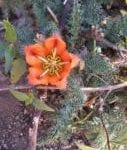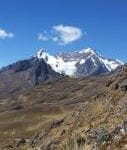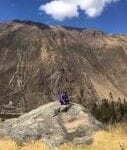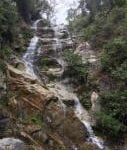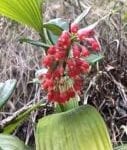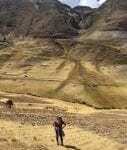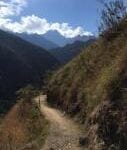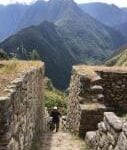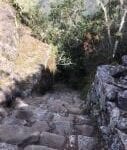Written by Thu Tran, MD,FACOG
August 11, 2017

A few months ago, Dr. Seidelman and her husband went to Peru and wrote a blog about her amazing experience. Since Peru had been on my bucket list for a very long time, I urged my husband to consider going to Peru for our summer vacation. David went hiking and camping in Peru up the entire “old Inca trail” a long time ago when he had finished a two year stint as a physician in the National Health Service Corps and was going to return to graduate school for another degree — he showed me similar photos to Dr. Seidelman’s trip. He still remembers having a challenging time climbing at high altitudes while his little Peruvian helpers (“sherpas”) were carrying his backpack, playing their native pan flutes as they climbed ahead of him. Happily, David agreed our family should go to Peru together. After all, we have a teenage son who, like so many teenagers in his generation, prefers spending time on his computer rather than being outdoors. Nature is magical, I often told him. Peru would be a perfect place to distract him from his gadgets.
As usual, I grabbed a book off one of our bedroom shelves to bring with me on the trip. I often keep myself busy on the plane by reading. I decided to pick a small book this time, as my suitcase and backpack were full of items and clothes for a long outdoor trip. Ironically, this book, “Into the Wild,” by Jon Krakauer, was about the fatal adventure to Alaska of a young American who grew up in Annandale, Virginia. My son read this book a few years ago in his early days in high school. I wonder if the purpose of having high school students read this book was to teach them how a careless youth can end his life prematurely, or to teach students the lesson of respecting the wild and its hidden dangers.
We missed our initial flight to NYC for a connecting flight to Peru because of a bad storm there. We ended up in Cusco, a city in the Peruvian Andes at 11,152 ft altitude, a day later than planned. Dr. Seidelman and others who had gone to Peru had warned us about altitude sickness. We were supposed to have two days to adjust to this high altitude. We were advised to drink a lot of coca tea, or just chew many coca leaves daily to help with altitude adjustment. Cusco, once the capital of the Inca empire, was a beautiful and lively city with narrow, very narrow cobblestone streets, so narrow that I was glad I was slim enough not to feel nervous that the tourist vans would crush me as I stood on the sidewalk. Those who are not fit would also have a very difficult time walking the streets of Cusco, as many of these streets are on steep hills, and walking on stones is not easy like walking on flat paved streets or grass.
On the third day of the trip, during our first night camping out on the mountain, my husband felt a little sick. He had a headache which we suspected was from the high altitude, and an unsettled stomach after dinner. He did not sleep well that night and decided not to hike the morning after. Our son and I, together with our tour guide and two horsemen, began our early climb through Lares Valley without David. It was an almost six hour trek to a 14,800 ft summit to see one of the five glaciers in this area. The path was full of exotic flowers, many of them our tour guide Edwardo classified as Aster or Fuschia species. The sceneries were so stunning I kept stopping to snap photos and wondering why it took me so long to finally travel to this enchanting area. The sky could not have been more blue and the mountain could not have been more green. I had this deep gratitude for the beauty of nature and for my ability to sort out the many colors, textures, scents and sounds around me. We should always been mindful and deeply grateful for living with our five senses intact.
When we got back from our morning hike, which ended in the afternoon, my husband looked better but cautiously warned our tour guide he might not do well camping for the second night. Camping was more like “glamping,” with air mattresses in our tent, meals prepared by a cook, tents set up by a team of father and son, and even a toilet tent in a scenic corner of our camping area. However, the 70F degree during the day became 30 at night, and I was shivering in the cold walking with David to the toilet tent the night before. Our tents were soaking wet with frost at night. David decided it was best to cancel the second camping night and stay in a warm hotel instead. David wanted to get better to make sure he could join us for the rest of our journey. He knew the limits of his body.
I, however, was upset that David did not “try harder” to stay the course. He looked a little tired but still with “good” color. His stomach had calmed down and he was able to eat lunch without feeling nauseous. Why couldn’t he go to bed earlier, wear more long sleeve shirts, put feet warmers in his socks and maybe…just maybe he would get well enough to keep the itinerary of hiking another 8 hours through Lares trek the morning after? I even offered my brown and blue striped scarf to keep his neck warm. There’s nobody around you in the tent to see you wear a woman scarf, I told him, why would you care? To my disappointment, David insisted that we should stay in an hotel that night. I reluctantly followed his suggestion to settle in an hotel several hours away, daydreaming about those enchanting trails through Lares trek, imagining how I might have seen the Victoria peak as our tour company promised.
David had a good night sleep at the hotel and had recovered by the morning. Our tour guide took us on a gorgeous 4 hour hike on another trail in the Andes where we saw some ruins (instead of the planned 8 hour hike through the other side of Lares trek, since our hotel was too far to drive back to that area). The subsequent morning, we took a train to the starting point of our hike on the Inca trail leading to Machu Picchu, the world famous ruins and one of the seven wonders of the world.
We all did very well trekking 11.5 miles (four hours in the morning and another three in the afternoon) on the Inca trail, the winding mountainous path full of orchids, Asters, Begonias, Fuschia, giant Begonias, fern trees and multiple medicinal plants. David was full of energy and I was always the one who lagged behind, marveling at the wild flowers. The tour guide had to stop now and then to remind me that “There will be more orchids ahead; we need to move along to get to Machu Picchu.”
Shortly after 2 PM, we began our last ascending climb on a rocky steep path, tougher than the last hill before reaching the finish line of the Marine Corp Marathon, to reach the Sun Gate where we looked downward into a valley and saw the magical place called Machu Picchu, an Inca ruins discovered in 1911by Hiram Bingham, a Yale University professor.
I finally finished the book “Into the Wild” on the way back from Peru. The story was mesmerizing and tragic, in a sense, about the folly of youth. Young people often have no fear for danger or death. Often with an impulsive brain, an unrealistic optimism or enthusiasm, and a high level of energy, these young adults think they are invincible. They can conquer any mountain, swim across any turbulent river, live in the wild with minimal preparation. That was what killed Chris McCandless, his youthful self confidence or over-confidence. Chris left a life of comfort after graduating from college, ventured alone into the wilds of Alaska, after numerous adventures in between, living in different areas and supporting himself through manual jobs. Not listening to the experienced locals, McCandless walked into the wild with a bag of rice, a book on edible plants in the wild, no map, no compass, no necessary tools to survive the harsh winter of Alaska. He spent sixteen weeks alone in the woods and stayed in an abandoned bus at night. The story ended tragically with Chris’ body found by some travelers to this remote part of Alaska. He died of starvation. A piece of paper asking for help from Chris was seen taped to the window of the abandoned bus. Chris McCandless died at 23 years old. The author also wrote about other well-known deaths in Alaska like the case of McCandless. They were all young, independent, impulsive, strong-willed, and many times, dysfunctional. All of them also possessed a deep love for the wilderness, a place where they believed they belonged.
In a way, I was the middle age version of Chris McCandless. I kept telling myself the night David felt sick that, if I was him, I would “bite the bullet” and keep going. I would have urged Edwardo the tour guide to push on with the 8-hour hike even if I had to “drag” myself behind him with my nausea and headache. I secretly thought David lacked the strong will needed for this life adventure. I thought that my adventurous older sister would have not given up that 8 hour hike no matter how bad she felt. My legs after the six hour hike without David were so sore that night at the hotel but, I said to myself, I would not have given up the 8 hour hike. Nothing could have been stronger than my will.
I might not have recovered well like David if I was in his condition and yet pressed on with the treacherous hike. I might have been even more dehydrated and sicker by the time I came back from the long hike, and I might have missed the enchanting trek on the Inca trail up to see Machu Picchu. Like Chris McCandless, I was strong-willed and would not have listened to my tour guide to rest and hydrate before proceeding on the next trek. Like McCandless, i would have had this false self confidence that I, unlike others, would have survived any task I was determined to achieve.
We need to know our limits. As the experienced adventurers stated in “Into the Wild,” we have to learn to respect the wilderness and beware of its dangers. David might not have experienced his headache and altitude sickness if we had spent a longer time in Cusco to adjust to our new environment. I could have fallen sick eating the little guava I found on the Inca trail before learning from my tour guide how wild fruits often are covered by a toxic alkaloid to protect them from insects.
Today, I took a little quiz in the NewYork Times’ article “How to Stay Safe in the Great Outdoors,” to see how much I understood about the dangers in the wilderness. I have never had an encounter in the wild with a mountain lion, bear, or even live snake! I have not had any tick bites, except from my dogs’ ticks when I was young. I have never encountered sharks (other than small sand sharks) in the ocean, although I have been in oceans from different continents. I have fished in Florida and caught some baby sharks, but they were not swimming along their parents in the water. I believe that was why I got only 60% of the questions right. As I saw my low score flashing on my computer screen, an automatic message was generated:
“Need some work. It’s a good idea to brush up on the best animal safety tips from expert sources like the National Park Conservation Association. For medical concerns, consult trusted sources like the CDC, and you should always seek professional medical assistance whenever you are in doubt about your health.
Do you think you might know more about the dangers in the outdoor than me? Do you think you might score more than 60% in this quiz? Try it to see how much you know. You might score very high or, like me, you might realize you need to brush up your knowledge on dangers in the wilderness so you won’t end up having a third party, like the reporter Jon Krakauer, write your autobiography and try to figure what was going on in your mind when you ventured into the wilderness unprepared. Here is the link to this quiz:
Tags:


